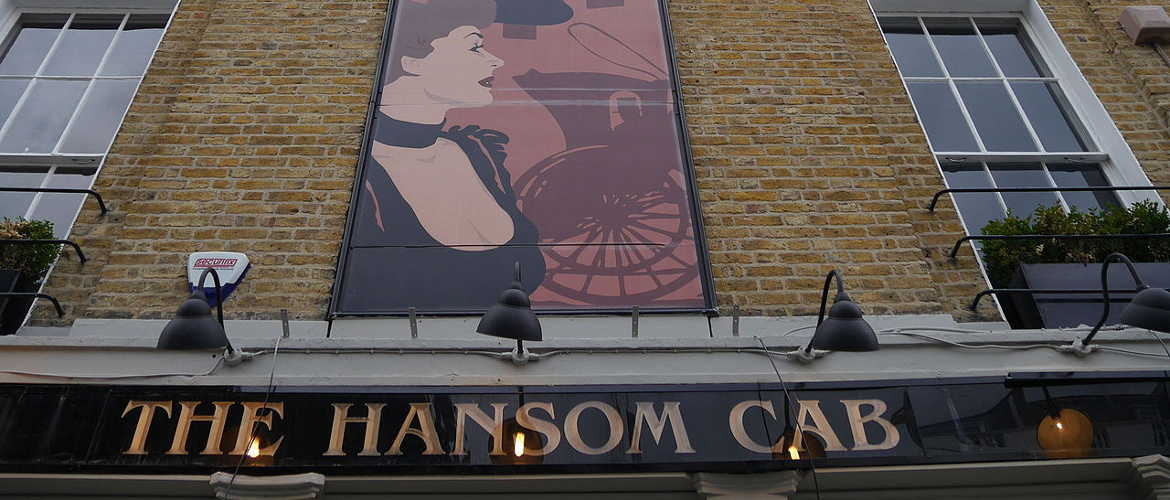Consider, if you will, an unsettling inheritance from a long-dead English architect, one Joseph Hansom.
Hansom was best known for designing important public buildings, especially churches, in the U.K., Australia, and South America. But in 1834 he patented the two-wheel, single-horse-drawn cab that bears his name.
The ill-fated hansom cab.
There’s no record of whether the cabs’ meters were on, but if they were, their clicking wasn’t measuring the miles as much as counting down the time left for hansom cabs on the city’s streets.
His work on the cab came during what might be called a lull in his career, coming as it did on the heels of his first professional job, a medical clinic in York.
The project drove him into bankruptcy.
To raise money, Hansom sold the cab patent for £10,000 to a British financier. The benefactor rode off into the sunset and never paid him.
If Hansom had offended some Romanian gypsies we’d no doubt acknowledge these events as having all the earmarks of a curse. But, he didn’t. So let’s forget about gypsy curses (and the eerie string music that accompanies them) and jump across the pond to New York, which is what hansom cabs did in 1869.
Well, the cabs didn’t jump, the idea did.
The New York Hansom Cab Company, which served Brooklyn and Manhattan, had its cabs manufactured locally. The original hansom cabs remained in Europe largely because of a shortage of horses anxious to swim the Atlantic.
The unmetered fare for riding in a New York hansom cab was 30 cents per mile for one person, 40 cents for two, and up to a dollar an hour waiting time. Those rates gave the cab company a nice, comfortable existence.
Until one night in February, 1907.
Enter one Harry N. Allen and his lady friend, two ordinary passengers in need of a ride. They secured a hansom cab to carry them from Rector’s, a fine eatery at Broadway and 44th Street, to Allen’s home on 58th Street.
Either the cab driver didn’t understand the concept of distance or he’d had a falling out with mathematics somewhere in his youth, but Allen wound up paying a five-dollar fare for a three-quarters of a mile ride.
That fare gouging turned out to be ill timed. Allen wasn’t so ordinary after all. He was a 30-year-old, well-connected businessman. He also may have had some gypsy DNA.
He not only cursed the cab driver—in the mundane sense of the word—he cursed the hansom cab business, too. In less than 10 months, Allen located clean, reliable motorized cabs, secured $8 million in financing, and attracted a group of backers that included William Randolph Hearst.
As described by Graham Hodges, author of Taxi! A Social History of the New York City Cabdriver, Allen turned the streets of Manhattan red—and if that doesn’t sound like a gypsy curse I don’t know what does. On October 1, 1907, New Yorkers saw “a parade of sixty-five shiny new red gasoline-powered French Darracq cabs, equipped with fare meters, down Fifth Avenue.”
On the following day, The New York Times printed a story on the new cabs that was nothing short of glowing.
There’s no record of whether the cabs’ meters were on, but if they were, their clicking wasn’t measuring the miles as much as counting down the time left for hansom cabs on the city’s streets.
Despite the best efforts of hansom cab drivers to run Allen’s taxicabs off the road—literally—by blocking streets and forcing taxis to swerve onto sidewalks, it was Allen who ran off the hansom cabbies. In the months that followed, Allen’s taxicabs (he coined the word by combining cab with taxi from taxi dancer) undercut an earlier pronouncement by Allan Lexow, president of the New York Hansom Cab Company, that none of his 4,900 customers would ever ride in a cab with a meter.
The Hansom curse had struck again.
Unlike hansom cabs, the taxicab (now yellow in color) became a symbol of modernity in New York and across the country. The New York City cab driver became a tourist attraction and entertainment icon.
Recently, though, the Times wasn’t as dewy-eyed about taxis. “The so-called e-dispatch services…have flooded neighborhoods where taxi service has long been spotty,” it reported, “and …they appeal to a new generation of tech-skilled riders who live on their phones…”
Have taxis inherited the hansom curse? Ponder, if you will, this final fact.
Uber and Lyft began plying the city’s streets as high-tech versions of private, unregulated, cars that were providing transportation in the city’s underserved areas.
New Yorkers called these illegal cabs gypsies.
(Eerie string music goes in here.)
Start your Sunday with a laugh. Read the Sunday Funnies, fresh humor from The Out Of My Mind Blog. Subscribe now and you'll never miss a post.
Mind Doodle…
Before Chicagoan John Hertz of rental car and truck fame rented vehicles, he rented rides in them. It was Hertz who, in 1915, started the Yellow Cab Company in Chicago. His choice of color was motivated by a University of Chicago research report that deemed yellow (with a bit of red in it) the the most visible color. New York City adopted the same yellow color for officially-licensed taxis. But according to Slate.com, Albert Rockwell, who incorporated the Yellow Taxi Cab Co. in New York City in 1912, was the first to paint taxis yellow. He did so to keep the peace at home. It seems his wife, Nettie, was fond of the color.

Interesting story about something we rarely think of in terms of its development. Was there really a shortage of horses in 19th century NY?
Hi J. David…
I didn’t find any references to a shortage of horses in New York City in the late 1800s. However, judging from the tactics used by the hansom cab drivers there was no shortage of horses’ asses.
— jay